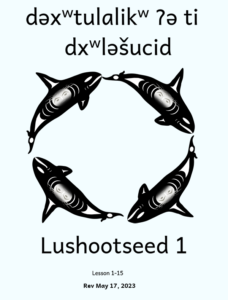Conversational Lushootseed: Foundational Skills
These units will hopefully make understanding some of the grammar and concepts easier. These units cover the alphabet, possessives, prefixes, asking a question, and of course, how to use the dictionary.
dəxʷtulalikʷ ʔə ti dxʷləšucid-1 PDF
The Lushootseed language has 46 charters in it, but for all practical purposes, only 41 are used. The Alphabet is derived from the International Phonetic Alphabet, which contains letters for sound not heard in English.
Of the sounds in Lushootseed that are not shared with English, all can be heard in other Native American languages.
Like many languages, Lushootseed has changed over time. About 1900 all the "n" sounds in Lushootseed were replaced with "d" sounds and all the "m" sounds were replaced with "b" sounds.
We say "Snohomish," because the word was written down by non-Indians before the change occurred.
After watching the above video, go to this page to get a full look at the Lushootseed area of the International Phonetic Alphabet.
Drills: Lushootseed Alphabet - sƛ̕əladiʔ
If on a mobile device please get the Quizlet App and open this link https://quizlet.com/510641664/match
The Lushootseed Dictionary is published by University of Washington Press and can be purchased here. 
When you look for something in the English section of the dictionary, the root meaning will start after the root symbol, √. Everything before the the root symbol is a prefix. (Not all words have this symbol)
Once you have the root meaning, you can look it up in the Lushootseed part of the dictionary.
If you are looking up a word in the Lushootseed section, you will likely do it by the root word. For example, if you look up pədt̕aqaʔ, you will find it under t̕aqa.
Likewise if you are looking up wolf, you would find it under tiqayuʔ, not stiqayuʔ. The "s" in stiqayuʔ is a nominalizer, which is used to make a verb a noun. See PREFIXES in another section.
When using the dictionary it's important to look for the dialect if one is listed. It will Show NL for Northern Lushootseed and SL for Southern Lushootseed. It may also show the initials for the informant that gave the researchers the word. For example, ʔəč̓əd has the initials EK. If you look at the beginning of the dictionary on page x, you'll find her initials listed there, where she is identified as a Northern Lushootseed speaker.
The Lushootseed Dictionary includes 2 markers to help learners figure out which sounds the Lushootseed vowels [a/ə/i/u] are supposed to make. These Lushootseed Vowels [i/u] offer 2 different sounds for learners to learn. The accents [á/à] tell us which of our many Lushootseed sounds to use. The acute accent [á] tells us to use our higher pitched sounds while the grave accent [à] tells us to use a lower pitch sound.
Here are some of the accent sounds with word examples.
á – c̓əc̓áʔus – thimbleberry sprouts
à – sik̓ʷədàc – snowberry bush
ə́ – č̓ə́qʷəb - bruised
ə̀ – kəlápx̌ʷə̀lč – jellyfish
í – yíyəq̓ʷ - pocket knife
ì – x̌ìq̓qíd – scratch head
ú – yúbəč – king salmon
ù – sč̓íyùyaʔ - twins
Possessives are usually attached to the noun. The primary possessives are d- for my, I see my cat. ʔəsšudxʷ čəd ti dpišpiš. The possessive for yours is ad-, I see your cat. ʔəsšudxʷ čəd ti adpišpiš. The possessive for ours is -čəɬ, I see our cat. ʔəsšudxʷ čəd ti pišpiščəɬ. And for you folks the possessive is -ɬəp. 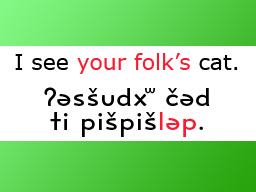 While there is no word for his, hers, and theirs in Lushootseed they are inferred, with the -s possessive. I see his dog. ʔəsšudxʷ čəd ti sqʷəbayʔs.
While there is no word for his, hers, and theirs in Lushootseed they are inferred, with the -s possessive. I see his dog. ʔəsšudxʷ čəd ti sqʷəbayʔs.
Drills: Possessives
If on a mobile device please get the Quizlet App and open this link https://quizlet.com/442113803/match
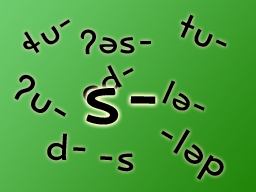 There are many prefixes in Lushootseed. This prefix, the "s" nominalizer, can change a verb into a noun.
There are many prefixes in Lushootseed. This prefix, the "s" nominalizer, can change a verb into a noun.
Or they can tell you the type of action that is occurring or even when something occurred, or to whom something belongs, in the term of a possessive.
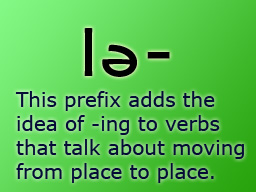
The lə- prefix adds the idea of -ing to verbs that talk about moving from place to place. For example, ʔibəš - walk, ləʔibəš - walking. lətəlawil - running, and ləƛ̕a - go to a specific location. As long as the verb is in motion it can have the lə- prefix. So a rabbit would be ləsaxʷəb ʔal ti sqʷaliʔ and a child on a trampoline would be ʔusaxʷəb.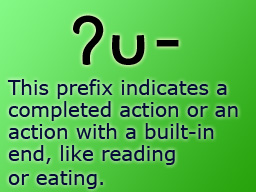
The ʔu- prefix indicates a completed action or an action with a builtin end, like reading - ʔutulalikʷ, and eating - ʔuʔəɬəd. Generally, any action that does not use a lə- or ʔəs- uses the ʔu- prefix.
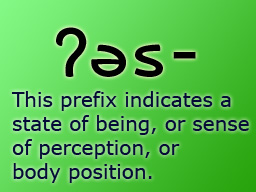
The ʔəs- prefix indicates a state of being or a sense of perception or body position. This can be seen in the word sleeping - ʔəsʔitut, and the common words of a state of being, ʔəshiiɬ - being happy, ʔəsx̌əɬ - being sick, and ʔəstagʷəxʷ - being hungry.
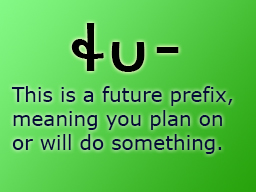
The prefix ɬu- indicates that something will take place in the future or is planned for the future. For example, ʔal ti ɬudukʷəɬdat ɬuqəlb - Tomorrow it will rain.
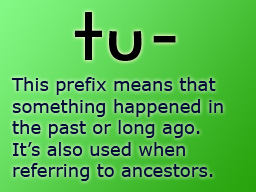
The tu- prefix indicates that something happened in the past, like tudukʷəɬdat - yesterday. It is more commonly used when describing something that happened long ago. It is also used when referring to one's ancestors.
tubad - father has past
tusk̓ʷuy - mother has past
Drills: Prefixes
If on a mobile device please get the Quizlet App and open this link https://quizlet.com/405155495/match
There are several ways to ask questions. The most common way is by using "ʔu," in a sentence that can be answered with a yes or no. ʔu is like a question mark and always goes second or third in a sentence, depending on if there is a čə- word.
ʔəstagʷəxʷ čəxʷ ʔu. - Are you hungry?
ʔəsƛ̕ubil čəxʷ ʔu. - Are you okay?
ʔəsx̌aƛ̕txʷ čəxʷ ʔu ti pəbkəd. - Do you like pumpkins?
stab, is how you ask what.
stab tiʔəʔ - What is this?
stab čəxʷ ɬutagʷš. - What are you going to buy?
gʷat, is how you ask who.
gʷat kʷi ʔəsʔitut. - Who is sleeping?

